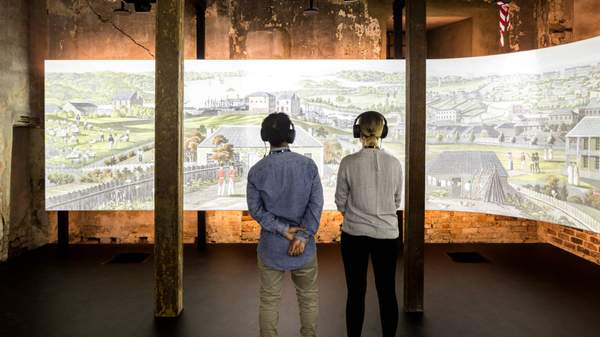Overview
Hyde Park Barracks, built in 1819 to house male convicts and now a UNESCO World Heritage-listed museum, has reopened after undergoing an $18-million makeover. In the year since it closed, Sydney Living Museums has installed state-of-the-art interactive experiences. Prepare to step back into convict history and discover its impacts on First Nations peoples.
Behind the revamp is Local Projects, a New York-based design studio, who has worked with Sydney Living Museums to breathe new life into the Barracks' 4000-strong collection, many of which are now on display for the first time. They've drawn on powerful stories, added interactive elements and created installations that surround you with visuals and sound over three storeys.
Brett Boardman
"The new design for Hyde Park Barracks places the personal narrative at the centre of the experience, creating a deeply moving journey for our visitors," said Sydney Living Museums Executive Director Adam Lindsay in a statement.
For tens of thousands of years, the land on which the museum stands was home to Gadigal People, who remain the land's traditional custodians. The new Museum explores their connection to the area, as well as how their lives where impacted by the Barracks' construction and, more generally, colonisation.
James Horan
Commissioned by Governor Lachlan Macquarie and designed by convict-turned-architect Francis Greenway, the building served as a convict prison from 1819–1848, when it transformed into temporary accommodation for female immigrants, mainly Irish orphans escaping the Great Famine. More than 100,000 people lived in the building between 1819 and 1887. But it wasn't until the early 1980s that archaeologists dug up the 120,000 objects – from coins and soup bones to clothing and bottles – left behind.
If you head to the new-look Hyde Park Barracks before Sunday, March 15, you'll get to see its (temporarily) transformed courtyard, too. For his site-specific art installation untitled (maraong manaóuwi), Wiradjuri/Kamilaroi artist Jonathan Jones has covered the building's 2500 square-metre courtyard with red and white stones from Wiradjuri Country. You'll spot a symbol on the rocks that can be interpreted in two ways (and conveys two very different historical perspectivies): the maraong manaóuwi (which means emu footprint in the local Gadigal language) and English broad arrow. You're invited to look at — and walk across — the artwork for free until it disappears mid-March. A heap of workshops are running alongside the installation, too, which you can check out over here.
Hyde Park Barracks Museum is open daily from 10am–5pm at Macquarie Street, Sydney, and tickets are $20–24.
Top images: Brett Boardman
